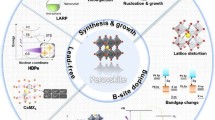Abstract
Application of lead-halide perovskite nanostructures for photovoltaic and light emitting applications depends on fashion of the surface termination. The reasonable choice of surface ligands for perovskite nanostructures prevent formation of trap states and contribute to chemical stability, wide opening of the bandgap, and intensity of absorption and photoluminescence of perovskite nanostructures. This work provides atomistic arguments for dual ligand protocol of surface passivation of fully inorganic perovskite quantum dots with fully organic ligands being a mix of cations (ethyl-ammonium) and anions (acetic) in nearly equal proportions. Computed binding energies of either individual ligands or anion-cation pairs demonstrate high stability in comparison to thermal energy and are concluded to be favourable choice in synthesis of colloidal perovskite quantum dots for light emitting applications.
Similar content being viewed by others
References
Protesescu, L.; Yakunin, S.; Bodnarchuk, M. I.; Krieg, F.; Caputo, R.; Hendon, C. H.; Yang, R. X.; Walsh, A.; Kovalenko, M. V., Nanocrystals of Cesium Lead Halide Perovskites (CsPbX(3), X = Cl, Br, and I): Novel Optoelectronic Materials Showing Bright Emission with Wide Color Gamut. Nano Lett 2015, 15 (6), 3692–6.
Kilina, S.; Kilin, D.; Tretiak, S., Light-Driven and Phonon-Assisted Dynamics in Organic and Semiconductor Nanostructures. Chem Rev 2015, 115 (12), 5929–78.
Sham, W. K. L. J., Self-Consistent Equations Including Exchange and Correlation Effects. Physical Review 1965, 140 (4A), 1133–1138.
Hohenberg, P.; Kohn, W., Inhomogeneous Electron Gas. Physical Review B 1964, 136 (3B), B864–B871.
Kresse, G.; Furthmuller, J., Efficient Iterative Schemes for Ab Initio Total-Energy Calculations Using a Plane-Wave Basis Set. Physical Review B 1996, 54 (16), 11169–11186.
Kresse, G.; Furthmuller, J., Efficiency of ab-initio total energy calculations for metals and semiconductors using a plane-wave basis set. Computational Materials Science 1996, 6 (1), 15–50.
Perdew, J. P.; Burke, K.; Ernzerhof, M., Generalized Gradient Approximation Made Simple. Physical Review Letters 1996, 77 (18), 3865–3868.
Kresse, G.; Joubert, D., From ultrasoft pseudopotentials to the projector augmented-wave method. Physical Review B 1999, 59 (3), 1758–1775.
Junkman, D.; Han, Y.; Vogel, D. J.; D., K., Ab Initio Analysis of Charge Carrier Dynamics in Organic-Inorganic Lead Halide Perovskite Solar Cells. Mater. Res. Soc. Symp. Proc. 2015, 1776, DOI: 10.1557/opl.2015.782.
Zhou, L.; Neukirch, A. J.; Vogel, D. J.; Kilin, D. S.; Pedesseau, L.; Carignano, M. A.; Mohite, A. D.; Even, J.; Katan, C.; Tretiak, S., Density of States Broadening in CH3NH3PbI3 Hybrid Perovskites Understood from ab Initio Molecular Dynamics Simulations. ACS Energy Letters 2018, 3 (4), 787–793.
Vogel, D. J.; Inerbaev, T. M.; Kilin, D. S., Role of Lead Vacancies for Optoelectronic Properties of Lead-Halide Perovskites. The Journal of Physical Chemistry C 2018, 122 (10), 5216–5226.
Vogel, D. J.; Kryjevski, A.; Inerbaev, T. M.; Kilin, D. S., Photoinduced Single- and Multiple- Electron Dynamics Processes Enhanced by Quantum Confinement in Lead Halide Perovskite Quantum Dots. The Journal of Physical Chemistry Letters 2017, 8 (13), 3032–3039.
Forde, A.; Kilin, D., Hole Transfer in Dye-Sensitized Cesium Lead Halide Perovskite Photovoltaics: Effect of Interfacial Bonding. The Journal of Physical Chemistry C 2017, 121 (37), 20113–20125.
Neugebauer, J.; Scheffler, M., Adsorbate-substrate and adsorbate-adsorbate interactions of Na and K adlayers on Al(111). Physical Review B 1992, 46 (24), 16067–16080.
Makov, G.; Payne, M. C., Periodic boundary conditions in ab initio calculations. Phys. Rev. B 1995, 51 (7), 4014–4022.
Meng, Q. G.; Chen, J. C.; Kilin, D., Proton reduction at surface of transition metal nanocatalysts. Molec. Simulation 2015, 41 (1–3), 134–145.
Brown, S. L.; Hobbie, E. K.; Tretiak, S.; Kilin, D. S., First-Principles Study of Fluorescence in Silver Nanoclusters. The Journal of Physical Chemistry C 2017, 121 (43), 23875–23885.
Kilina, S.; Velizhanin, K. A.; Ivanov, S.; Prezhdo, O. V.; Tretiak, S., Surface Ligands Increase Photoexcitation Relaxation Rates in CdSe Quantum Dots. Acs Nano 2012, 6 (7), 6515–6524.
Author information
Authors and Affiliations
Rights and permissions
About this article
Cite this article
Forde, A., Inerbaev, T. & Kilin, D. Role of Cation-Anion Organic Ligands for Optical Properties of Fully Inorganic Perovskite Quantum Dots. MRS Advances 3, 3255–3261 (2018). https://doi.org/10.1557/adv.2018.552
Published:
Issue Date:
DOI: https://doi.org/10.1557/adv.2018.552




